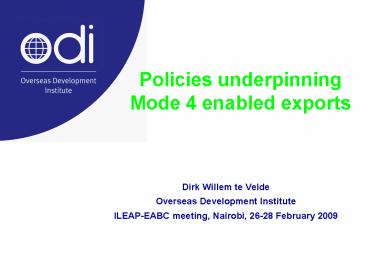Policies underpinning Mode 4 enabled exports - PowerPoint PPT Presentation
1 / 16
Title:
Policies underpinning Mode 4 enabled exports
Description:
Key debates (see papers by Cali and Te Velde at ODI) underpinning attitudes towards migration: ... What is the coverage of temporary labour mobility in ... – PowerPoint PPT presentation
Number of Views:25
Avg rating:3.0/5.0
Title: Policies underpinning Mode 4 enabled exports
1
Policies underpinning Mode 4 enabled exports
- Dirk Willem te Velde
- Overseas Development Institute
- ILEAP-EABC meeting, Nairobi, 26-28 February 2009
2
Overview
- Key debates (see papers by Cali and Te Velde at
ODI) underpinning attitudes towards migration - Economics Migration and development debate
- Policy Migration / labour vs trade/investment
approach - What is the coverage of temporary labour mobility
in international trade and special migration
agreements and are such provisions the binding
constraint to trade? - Ways forward (in context of the global financial
crisis).
3
Migration and development
Remittances (US billion)
- Domestic capabilities (predominantly skilled,
drain?) - Ability to sell a service / Remittances
- Incentives for human capital formation (nurses,
CV) - Effects on trade and FDI (networks, diaspora)
- Return migration (brain gain)
4
Migration and exporting countries
5
Policies to make (temp) migration work for
development
- In source country
- Incentives to stay (pay and working conditions,
normal development policies such as a good
investment climate) - Return migration programmes
- Promote domestic capacity (e.g. training
programmes) - In destination country
- Use diaspora organisations, enable remittances
- Lift constraints to temporary migration
6
Labour/migration approach towards migration
- Often no managed migration policy and no
distinction between temporary and permanent - Control over borders (visas)
- Protecting domestic workforce (work permits)
- Safeguard quality of services provided
(professional regulations) - Filling gaps in labour markets (special temporary
migration schemes)
7
Trade/Investment approach towards migration
- Investment allow work permits for foreign
investors - Trade, setting rules so that trade in services
via temporary migration (mode 4) can take place - Defining trade via mode 4
- Trade principles Most favoured nation, National
treatment and domestic regulation
8
Mode 4 trade provisions
- Mode 4 relates to people travelling abroad to
provide a service for a limited period where
contact with the client are a key to the service - Applies to measures concerning temporary movement
?of individuals providing services ?and of
individuals employed by a (foreign) service
provider, e.g. - ICT programmers in multinational corporations,
Tour operators, Nurses? - GATS categories BV, CSS, ICT, IP
- EPA categories ICT (to 3 years), GT (1 year),
BSS (90 days in 1 year) - Does not cover domestic labour market or visa
issues - Progress on Mode 4 commitments in GATS has been
slow and often with little meaning in scope and
effect. But not much better at EPA level, and at
regional level? Some success in special schemes
9
GATS Mode 4 commitments (slow progress)
10
RTAs and migration provisions
- Four types of regions depending on the degree of
labour mobility (World Bank) - Full labour mobility (EU, EFTA, CER)
- Market access for certain groups (e.g. CARICOM,
NAFTA, Europe Agreements, US-Chile) - Based on GATS mode 4, with additional provisions
(ASEAN, EU Med agreements, EU-Mexico, EU-Chile
and MERCOSUR) - No effective market access provisions (APEC,
COMESA)
11
Special migration schemes
Number of countries admitting workers under
special schemes, circa 2005
Source Abella (2006)
12
Mode 4 restrictions and possible solutions
- Quantitative restrictions (increase quotas, e.g
for CSS) - Favouring skill levels and ICTs (extend scope of
skill levels and categories included) - Economic needs tests (clarify tests)
- Recognition of experience and qualifications
(work on mutual recognition agreements) - ? Consult with the private sector
13
Mode 4 quantitative restrictions binding
constraint to trade in services
H1B Visa into the US
Source Department of Homeland Security, National
Foundation for American policy, American Council
on International Personnel
14
But domestic capacity constraints can also be a
binding constraint
Non-EU nurses in UK (few LDCs)
Source UK Nursing Midwifery Council (2004/05)
15
Regulatory constraints can also be binding
- E.g. recognition of the qualification of Ugandas
tour operators in the region - Or Mauritius and engineering MRAs with the UK.
Steps - There needs to be a recommendation by industry
partners to the Joint Committee, which is usually
set up to ensure implementation of the agreement. - There need to be market access commitment (this
is a policy, and is logical, as without it an MRA
is not binding, but it is not a requirement
written on paper) - There needs to be safeguards as regards the
quality of the agreement.
16
Three ways forward on Mode 4
- Global financial crisis has changed priorities on
trade policies need to address the increase in
protectionism on migration (e.g. UK, Thailand and
Bangladesh). - Bind, clarify and improve current access and
treatment of migrant labour according to private
sector needs. Low expectations on GATS? Little in
EPAs? But EAC? - Improve capacity (skills) and domestic regulatory
constraints (qualifications) ? Aid for Trade

